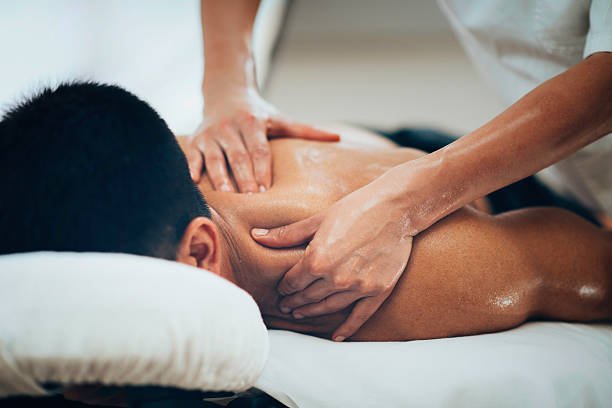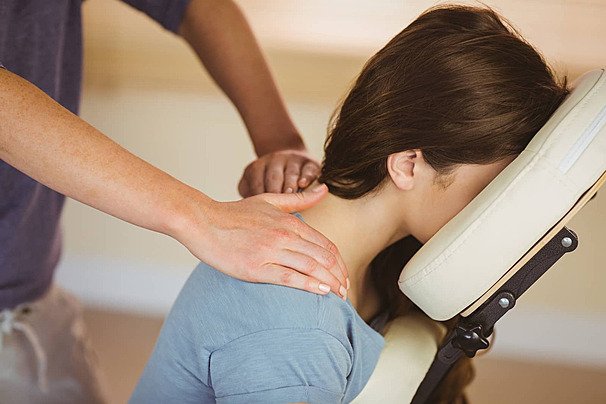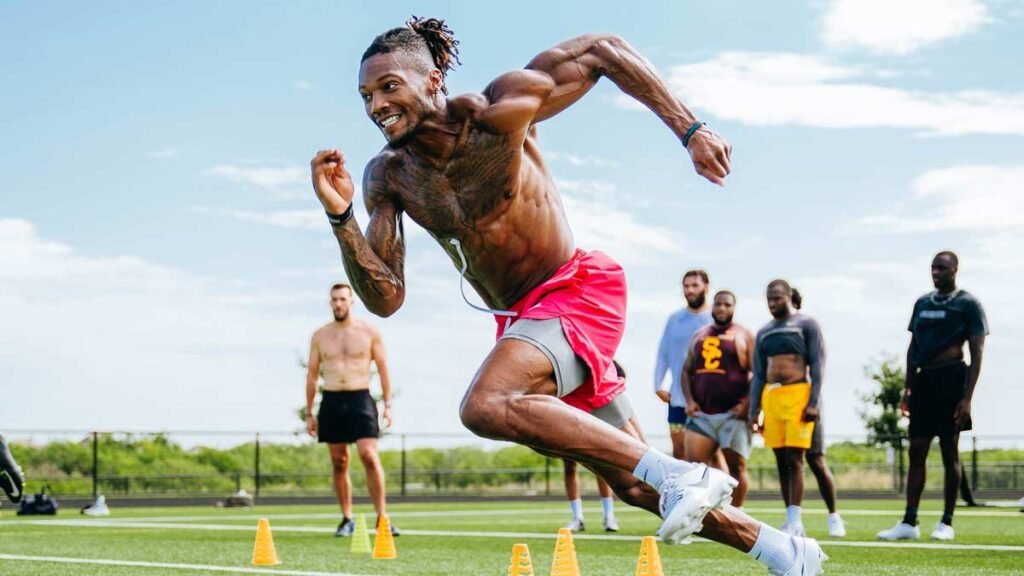Are Sports Massages Painful? The Truth About Discomfort and Recovery

I winced when my physiotherapist first suggested sports massage. Like many athletes, I’d heard the horror stories about excruciating deep tissue work that left people hobbling home.
Are Sports Massages Painful?
Sports massage doesn’t have to be a painful ordeal. Modern sports massage therapy focuses on therapeutic effectiveness rather than enduring unnecessary discomfort. Research shows that whilst some temporary discomfort may occur, the benefits far outweigh any brief uneasiness.[1][2]
The level of discomfort experienced during sports massage varies significantly based on individual pain thresholds, muscle condition, and the specific techniques employed by your therapist. What one person finds mildly uncomfortable, another might perceive as deeply relaxing.[3]
Understanding the “Good Pain” Phenomenon
Many clients describe sports massage sensations as “good pain” – that productive feeling when tight muscles finally release their grip. This therapeutic discomfort signals that deep tissue work is effectively breaking down adhesions and improving circulation.[4][5]
According to research published in BMJ Open Sport & Exercise Medicine, sports massage can reduce delayed onset muscle soreness (DOMS) by 13% compared to passive recovery. The temporary discomfort during treatment translates into significant pain reduction afterwards.[6][1]
The Science Behind Sports Massage Discomfort

How Pressure Creates Relief
Sports massage employs firm pressure to reach deeper muscle and connective tissue layers. This pressure breaks down muscle knots, improves blood flow, and releases tension that’s accumulated from training or daily activities.[2][7][5]
The discomfort isn’t arbitrary torture – it’s your nervous system responding to therapeutic intervention. Research indicates that massage activates mechanoreceptors and proprioceptors, which can actually reduce pain perception through the gate control theory of pain.[4]
Individual Pain Thresholds Matter
Your pain tolerance plays a crucial role in your massage experience. Athletes often possess higher pain thresholds than sedentary individuals, making sports massage more comfortable for active people. However, even beginners can enjoy effective treatment when therapists adjust their approach accordingly.[8]
A study involving 150 participants found that both heavy rolling massage and manual massage significantly increased pain thresholds compared to control groups. This suggests that regular massage may actually improve your tolerance for therapeutic pressure over time.[4]
Sports Massage vs Physiotherapy: Different Approaches to Pain Relief
Whilst sports massage excels at recovery and performance enhancement, physiotherapy addresses specific injuries and movement dysfunctions. Sports massage supports active lifestyles through tension relief and improved circulation, whereas physiotherapy provides diagnosis-driven treatment for pain and rehabilitation.[9]
Think of sports massage as maintenance for your musculoskeletal system – like servicing your car regularly. Physiotherapy, however, is more like taking your car to the mechanic when something’s actually broken.
Dr. Jason Brummitt notes in his research that “despite the fact clinical research has been performed, a poor appreciation exists for the appropriate clinical use of sports massage”. This highlights the importance of understanding when each therapy is most beneficial.[10]
Case Study: Professional Athletes and Pain Perception

Elite basketball players who received pre-event sports massage showed significantly improved performance indicators, including vertical jump height and muscle strength, despite experiencing some initial discomfort during treatment. The temporary uneasiness translated into measurable performance gains that lasted throughout their competition.[11]
Similarly, marathon runners who received post-event sports massage experienced 30% less delayed onset muscle soreness compared to those who relied solely on passive recovery. These athletes reported that any discomfort during treatment was vastly outweighed by the accelerated recovery benefits.[12]
Practical Strategies for Managing Massage Discomfort
Communication Is Key
Your massage therapist can’t read your mind. If pressure feels too intense, speak up immediately. Effective sports massage works within your comfort zone whilst still achieving therapeutic goals.[13][3]
Professional therapists understand that everyone’s different. They’ll adjust pressure, technique, and focus areas based on your feedback and tolerance levels.[5][14]
Preparation Makes a Difference
Arrive hydrated and avoid intense training immediately before your session. Dehydration and pre-existing muscle fatigue can amplify discomfort unnecessarily.[15]
Consider scheduling your first massage on a rest day when muscles aren’t already compromised from recent workouts.
Post-Massage Expectations
You might experience mild soreness for one to three days following treatment, similar to delayed onset muscle soreness after exercise. This normal response indicates that therapeutic changes are occurring within your muscle tissue.[15]
Proper hydration, gentle movement, and adequate rest help minimise post-massage discomfort whilst maximising recovery benefits.[14][5]
Expert Insights on Sports Massage Benefits
Modern research demonstrates that sports massage offers numerous advantages beyond simple relaxation. Studies show improved flexibility, reduced muscle tension, enhanced circulation, and faster recovery times.[16][2]
A comprehensive review published in 2023 found that whilst massage doesn’t directly improve motor abilities, it significantly reduces pain perception and delayed onset muscle soreness. These psychological and physiological benefits contribute to improved training consistency and performance outcomes.[2]
The psychological benefits shouldn’t be overlooked either. Sports massage activates the parasympathetic nervous system, reducing stress hormones like cortisol whilst boosting mood-enhancing neurotransmitters.[17][18]
Actionable Takeaways
Before your first session:
- Schedule on a rest day to minimise existing muscle tension
- Arrive well-hydrated to reduce sensitivity
- Communicate your pain threshold and any concerns with your therapist
During treatment:
- Speak up if pressure becomes uncomfortable – your therapist will adjust
- Focus on breathing deeply to help your muscles relax
- Remember that mild discomfort often signals effective treatment
After your massage:
- Expect possible mild soreness for 1-3 days (this is normal!)
- Stay hydrated to help flush metabolic waste from treated muscles
- Avoid intense exercise for 24 hours to maximise recovery benefits
Conclusion
Sports massage needn’t be a painful experience that you dread. With proper communication, realistic expectations, and a skilled therapist, you can enjoy significant recovery and performance benefits without unnecessary suffering.
The temporary discomfort during treatment pales in comparison to the lasting relief from muscle tension, improved flexibility, and accelerated recovery that follows. Remember – if sports massage helps professional athletes perform at their peak, imagine what it could do for your training and daily comfort levels.
Ready to experience the benefits of professional sports massage? Don’t let fear of discomfort prevent you from discovering this powerful recovery tool that could transform your athletic performance and overall well-being.
Ready to get personalized relief? Book your sports massage session today and experience neck pain relief firsthand.
https://mysportinjury.janeapp.co.uk/#/staff_member/8
- https://bmjopensem.bmj.com/content/6/1/e000614
- https://pubmed.ncbi.nlm.nih.gov/37368560/
- https://essentialchiropractic.co.uk/does-sports-massage-hurt-what-to-expect/
- https://pmc.ncbi.nlm.nih.gov/articles/PMC4587678/
- https://www.releafphysio.com/post/is-sports-massage-painful-debunking-the-discomfort-myths
- https://pmc.ncbi.nlm.nih.gov/articles/PMC7228568/
- https://www.wilmslow-physio.co.uk/sports-massage/
- https://dergipark.org.tr/en/download/article-file/91722
- https://onebodyldn.com/physio-london/massage-vs-physio
- https://pmc.ncbi.nlm.nih.gov/articles/PMC2953308/
- https://train.fitness/personal-trainer-blogs/the-role-of-sports-massage-in-injury-prevention-and-rehabilitation
- https://www.tracknfieldmassage.com/post/unlocking-the-potential-examining-the-latest-research-on-the-impact-of-massage-on-sports-recovery
- https://www.adjustmassage.co.uk/blog/the-truth-about-sports-massage-debunking-the-myth-of-pain
- https://healthbyscience.co.uk/health/sports-massage-painful/
- https://katiebellphysio.com/how-long-are-you-sore-after-a-sports-massage/
- https://pmc.ncbi.nlm.nih.gov/articles/PMC10302181/
- https://www.releafphysio.com/post/psychological-effects-of-sports-massage
- https://rehabhub.co.uk/2025/05/01/the-benefits-of-sports-massage-what-science-really-says/
- https://eprints.whiterose.ac.uk/id/eprint/161620/7/Effect of sports massage on performance and recovery a systematic review and meta-analysis.pdf
- https://www.research.herts.ac.uk/ws/files/42103345/sports_11_00110_v3.pdf
- https://www.primeperformancephysio.co.uk/sportsmassageblog
- https://www.balticsportscience.com/cgi/viewcontent.cgi?article=2225&context=journal
- https://www.sciencedirect.com/science/article/pii/S1836955316000187
- https://www.origym.co.uk/blog/what-to-expect-from-a-sports-massage/
- https://jamanetwork.com/journals/jamanetworkopen/fullarticle/2821154
- https://salfordcityclinic.com/sports-massage/
- https://www.manchesterphysio.co.uk/treatments/massage/index.php
- https://www.sciencedirect.com/science/article/pii/S1836955319300190
- https://www.physiotherapybrighton.co.uk/opinion/sports-massage-vs-physio
- https://pubmed.ncbi.nlm.nih.gov/15730338/
- https://www.totalsportsrehab.co.uk
- https://www.sciencedirect.com/science/article/pii/S2468781219302036
- https://northwichfootclinic.co.uk/is-a-sports-massage-painful/
- https://www.balticsportscience.com/journal/vol17/iss2/6/
- https://red-physiotherapy.co.uk/sports-massage-or-physiotherapy-what-do-i-need/
- https://pmc.ncbi.nlm.nih.gov/articles/PMC7043719/
- https://concordiaclinic.com/blog/does-a-sports-massage-hurt-what-to-expect/
- https://www.ottophysiotherapy.co.uk/sports-massage/
- https://helpingphysio.com/physiotherapy-quotes/
- https://www.goodreads.com/quotes/tag/physiotherapy
- https://www.releafphysio.com/post/do-sports-massage-work
- https://glossgenius.com/blog/massage-quotes
- https://www.spirehealthcare.com/treatments/perform-rehabilitation/sports-massage/
- https://careoptionsforkids.com/blog/physical-therapy-quotes/
- https://pubmed.ncbi.nlm.nih.gov/32426160/
- https://hevycoach.com/pt-motivational-quotes/
- https://journal.wrpublishing.id/index.php/pi/article/download/29/44
- https://purephysiotherapy.co.uk/services/sports-physio-services/sports-massage/
- https://pmc.ncbi.nlm.nih.gov/articles/PMC11979224/
- https://thephysiotherapydoc.com/news/massage/sports-massage-for-performance
- https://core.ac.uk/download/pdf/267577625.pdf
- https://www.instagram.com/reel/DAJA46vPG3f/
- https://www.drgraeme.com/articles/2023/12/the-benefits-of-sport-massage
- https://www.youtube.com/watch?v=6vkWyKfOc3A
- https://bmjopensem.bmj.com/content/11/1/e002486
- https://www.whitehouse-clinic.co.uk/articles-and-advice/a-detailed-guide-to-sports-massage
- https://www.youtube.com/watch?v=8doAsw8ieuo

